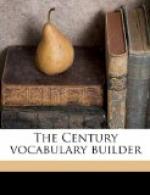EXERCISE — Relationships
1. For each of the following words (a) determine what families are intermarried, (b) ascertain the exact contribution to the household by each family represented, and (c) make as complete a list as possible of cognate words.
Reject Oppose Convent Defer Omit Produce Expel
2. Test the extent of the intermarriages among these words by successively attaching each of the prefixes to each of the main (or key) syllables. (Thus re-ject, re-fer, re-pel, etc.)
Two Admonitions
In tracing verbal kinships you must be prepared for slight variations in the form of the same key-syllable. Consider these words: wise, wiseacre, wisdom, wizard, witch, wit, unwitting, to wit, outwit, twit, witticism, witness, evidence, providence, invidious, advice, vision, visit, vista, visage, visualize, envisage, invisible, vis-a-vis, visor, revise, supervise, improvise, proviso, provision, view, review, survey, vie, envy, clairvoyance. Perhaps the last six should be disregarded as too exceptional in form to be clearly recognized. And certainly some words, as prudence from providentia, are so metamorphosed that they should be excluded from practical lists of this kind. But even in the words left to us there are fairly marked divergences in appearance. Why? Because the key-syllable has descended to us, not through one language, but through several. As good verbal detectives we should be able to penetrate the consequent disguises; for wis, wiz, wit, vid, vic, and vis all embody the idea of seeing or knowing.
On the other hand, you must take care not to be misled by a superficial resemblance into thinking two unrelated key-syllables identical. Let us consider two sets of words. The first, which is related to the tain group (see Tain below), has a key-syllable that means holding: tenant, tenement, tenure, tenet, tenor, tenable, tenacious, contents, contentment, lieutenant, maintenance, sustenance, countenance, appurtenance, detention, retentive, pertinacity, pertinent, continent, abstinence, continuous, retinue. The second has a key-syllable that means stretching: tend, tender, tendon, tendril, tendency, extend, subtend, distend, pretend, contend, attendant, tense, tension, pretence, intense, intensive, ostensible, tent, tenterhook, portent, attention, intention, tenuous, attenuate, extenuate, antenna, tone, tonic, standard. The form of the key-syllable for the first set of words is usually ten, tent, or tin; that for the second tend, tens, tent, or ten. You may therefore easily confuse the two groups until you have learned to look past appearances into meanings. Thenceforth the holdings and the stretchings will be distinct in your mind—will constitute two great families, not one. Of course individual words may still puzzle you. You will not perceive that tender, for example, belongs with the stretchings until you go back to its primary idea of something stretched thin, or that tone has membership in that family until you connect it with the sound which a stretched chord emits.




